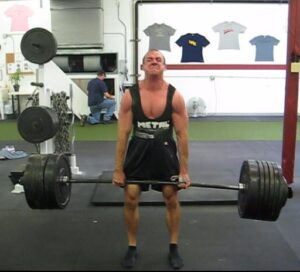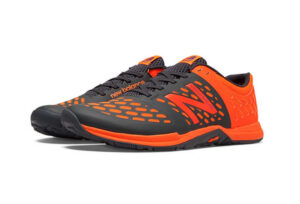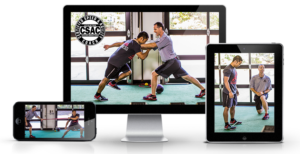7 Thoughts on Speed, Agility, and Quickness Training
A huge majority of sporting outcomes are heavily dependent on speed, agility, and quickness. The fact that these athletic qualities are such “game changers” also makes them a fun topic to cover in lectures and writing. To that end, I thought I’d pay specific attention to speed, agility, and quickness in today’s post. It’s especially timely, given the great introductory sale on Complete Speed Training that’s going on this week.
1. Footwear matters.
To me, all speed, agility, and quickness training discussions need to begin with footwear, as it directly impacts how you produce and reduce force with respect to the ground.
If you’re in heavier sneakers, good luck trying to “feel” fast.
If you’re in shoes with huge heel lifts, just try recruiting your posterior chain effectively during your movement training.
Finally, and perhaps most importantly, if you’re in sneakers without the right amount of lateral support, have fun trying to change directions. This has been a huge issue with some of the minimalist sneakers on the market; athletes will actually roll out of the shoes during changes of direction in spite of the fact that they have sufficient neuromuscular control to execute the exercise perfectly. It’s one reason why I was so glad to contribute to the discussion when New Balance was designing the newest versions of the Minimus.
Before you worry about cutting-edge training programs and meticulous coaching cues, make sure you’ve got the right stuff on your feet.
2. Don’t overlook individual differences.
It’s incorrect to assume that all athletes need to be coached the same with respect to movement training drills. Different athletes have different builds, and there will be subtle deviations from “the ideal” positions we envision in our minds. Obviously, limb and torso lengths play into this, but joint structure may impact things as well. As an example, someone who lacks hip internal rotation – whether it’s because of a bony block, capsular changes, or hip retroversion – might need to work from a more “open” (toes slightly out) athletic stance.
Understanding what “normal” looks like is important, but don’t think “abnormal” is necessarily always inappropriate.
3. It’s easier to make a fast guy strong than it is to make a strong guy fast.
I heard this line so long ago that I honestly don’t even remember where it originated. Still, I wish I’d really appreciated just how true it really was back then!
Many athletes are blessed with natural reactive ability. They’re really proficient at using the stretch-shortening cycle to create awesome athletic movement – even in the absence of what one might consider “good strength.” These athletes thrive when you simply get them stronger.
At the other end of the spectrum, you’ll find athletes who are very strong but completely unable to display that force quickly. They need to spend more time training speed than they do working on continuing to build (or maintain strength).
If you compare these two scenarios, though, the former (fast guy getting stronger) takes place much quicker than the latter (strong guy getting fast). There are a lot of different reasons this is the case, but at the end of the day, I think the biggest one is that it’s difficult to teach an athlete to relax.
Guys who are naturally fast seem to “accidentally” know how to turn off unwanted muscular tension. Guys who are naturally strong usually resort to brute force to try to solve every problem. If you need further proof, just watch me (or any other powerlifter) play golf!

4. Movement quality falls off with a growth spurt – but good training can help attenuate that drop-off.
When kids hit puberty and their adolescent growth spurt, it’s not uncommon to see some seriously uncoordinated athletes on the field, ice, or court. Beyond just the range of motion limitations that may have emerged overnight as bone growth has outpaced that of muscles and tendons, we also have to appreciate that the center of mass has moved further up away from the base of support – and that creates a more unstable environment.
This dramatic shift in the 12-15 age range explains why kids who dominated the youth ranks often don’t pan out as high-level high school or collegiate ranks. Just being a Little League all-star doesn’t really predict being a Major League Baseball all-star very well at all.
The good news is that we can attenuate – or minimize – the drop-off in athleticism that takes place with the adolescent growth spurt by incorporating effective training principles. As always, playing multiple sports and engaging in activities that provide a wide range of movements is essential. Moreover, we can integrate mobility drills and coach athletes on proper movement quality. And, finally, not to be overlooked is the role of strength training. Put 10-15 pounds of muscle mass on a young athlete’s lower body, and his center of mass will definitely be much closer to the base of support, creating a more stable environment. Of course, the strength that also emerges from that training will also go a long way in improving movement quality. This is why I think ages 11-12 are some of the best times to get involved in entry-level strength training programs, even if it’s just 1-2 times per week.
5. Moving well is as much about “reads” as it is about speed.
If you talk to most up-and-coming baseball players, they’re generally concerned with their “60 times.” If a player runs below a 6.5, he’d be considered elite caliber speed. Running between 6.6 and 6.7 would be excellent speed, 6.8-6.9 average speed, and 7.0 and below would be sub-par. These numbers are testing pretty regularly at various events in the high school ranks, but not much thereafter.
As a result, we don’t really have a true frame of reference for how “fast” guys are in the big leagues. Well, I’m here to tell you that you’d be sorely disappointed if you tested 60s of all MLB players. There would be a lot of 6.8-7.1 speed among position players, and you might only find 2-3 sub-6.7 guys on each roster. Game-changing speed really isn’t as common as you might think, and for every Billy Hamilton or Jacoby Ellsbury, there are a lot of guys who have become good baserunners more because they have learned how to run the bases, get good jumps, and understand situational baseball.
Baserunning is very much an art as much as it is an athletic endeavor, so you can do all the speed, agility, and quickness drills you want, but they won’t have nearly the effect you desire if guys simply don’t understand how to read and react to the game around them. This is surely the case in every other sport you’ll encounter short of track and field, too.
6. Good movement training programs need a mix of coaching and competition.
If you want to get faster, I think it’s crucial to have both coaching and competition elements in your training. With respect to coaching, you obviously have to cue athletes into higher quality movements; otherwise, you’re just further ingraining faulty patterns. This is analogous to driving an out-of-alignment car as fast as you can.
Conversely, I think there is something to be said about shutting up and just letting athletes run fast and compete with each other. Most elite sprinters train as part of groups, not individually. The same can be said of the best NFL combine preparation set-ups; guys push each other to get better. Timing and mirror drills are great ways to cultivate this competitive spirit in the training environment.
Ideally, you get a little bit of both competition and coaching in every movement training session. As I look at our typical week with our pro guys, our heaviest speed, agility, and quickness days are Wednesday and Saturday. Wednesdays tend to be less coaching intensive and more competition as the athletes sprint together. On Saturdays, things are more coaching intensive as we work indoors with everything 30 yards or less in distance. I’ll do more video work, and rarely have more than one guy sprinting at a time. As the season approaches, we’ll integrate more of the coaching intensive work prior to strength training on Mondays as well.
7. Video has changed the game.
Video – and more specifically, slow-motion video – has changed how we coach movement training dramatically. We spend a lot of time coaching proper angles – whether it’s torso lean or shin positioning – and being able to freeze-frame videos and show athletes where they are at various points in time can help an athlete to acquire or hone new skills much quicker than in previous years. If you’re not videoing speed, agility, and quickness work, start!
One word of caution, though: don’t let video interrupt the “flow” of the session. If you’re not careful, you can wind up watching and discussing video for 5-10 minutes between each set. It’s important to use the video as a resource, but not rely on it so heavily that it interrupts quality work.
Wrap-up
Speed, agility, and quickness training are incredible broad topics, so I’m really just scratching the surface with these seven observations. If you’re looking for a more exhaustive resource from one of the best coaches and teachers in the strength and conditioning field, I highly recommend the Certified Speed and Agility Coach course from Lee Taft. This excellent product is required viewing for all our coaches at CSP.






